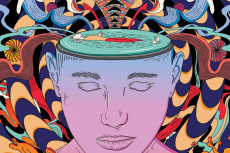

A psychedelic experience is a temporary altered state in which the individual experiences increased sensory perception with illusionary changes. One may grasp access to inner thoughts and feelings that are usually repressed, may have enhanced mental imagery and no longer feel like themselves; known as ego dissolution. The brain is organised into different networks. Psychedelics can disrupt these resting state networks and can increase regions of connectedness; as seen in patients who take LSD or psilocybin.
MDMA (also sometimes referred to as ecstasy) is an empathogen that inhibits monoamine uptake. Monoamines have a variety of roles in the brain, for example monoamine dopamine (a neurotransmitter) plays a part in control of movement, and emotions. The brain requires a good balance of dopamine to achieve physical and mental wellbeing. MDMA operates by increasing the levels of monoamines in the central nervous system for enhanced effects. Post-traumatic stress disorder causes a reduction in couplings in the brain. Reductions in couplings can lead to feelings of anxiety. MDMA increases the coupling between the hippocampus and amygdala which improves the ability to contextualise emotional information, hence its use for PTSD.
Ketamine is a dissociative that acts as a selective antagonist of NMDA receptors found on nerve cells. NMDA receptors are glutamate receptors, glutamate is an excitatory neurotransmitter that can cause a range of effects, especially those involved in cognition, learning and memory. Ketamine has been used clinically for anaesthesia and lower doses used as an anti-depressant. For inhibiting resting state networks associated with mood and depression, it reduces connectivity between the prefrontal cortex and posterior cingulate cortex. When ketamine binds to NDMA, GABAergic interneuron activity is inhibited, so less excitation leads to a reduction in glutamate release. As a result, glutamergic neurones release more glutamate due to increased excitation. More glutamate release can have a range of effects such as synaptogenesis, changes in synaptic strength and neurogenesis. This rearrangement of existing synaptic networks is believed to alleviate the symptoms of depression.
LSD is a lysergic drug that binds to serotonin (5HT2) receptors. Serotonin is a neurotransmitter that contributes to mood, appetite, sleep and more. LSD increases brain connectedness. Thus, LSD enhances connectivity of the visual cortex to other areas of the brain, so one can see or experience other images or images that have been stored in the brain, for example memories, places, smells or sounds.
LSD can be used to reduce anxiety in patients with terminal illness (like cancer), and a treatment for depression. It must be taken in the correct setting (such as a dim room with a trained clinician) with the right mood (positive attitude towards outcome) otherwise it can give adverse effects, causing panic attacks or extreme disorders. LSD remains trapped in the serotonin receptors for hours causing it to continuously fire action potentials. This disruption of brain networks helps sufferers of anxiety and depression to change their view on life. LSD causes a decreased blood flow in the default mode network correlating to strong changes in consciousness, characterised as ego dissolution. Ego dissolution is described as a feeling where the boundary that separates you from the world dissolves and so many people feel connectedness with themselves and others. Therefore, one can go from quite pessimistic and sad to optimistic and open.
Conclusively, psychedelics disrupt resting brain networks leading to an altered state of mind or physiological state. Varying doses change their effects and each individual can respond differently to the drug. Clinical uses of psychedelics are vastly different from recreational and should be managed carefully to receive the benefits.
image-https://www.newscientist.com/article/mg23631530-300-mind-menders-how-psychedelic-drugs-rebuild-broken-brains/

0 Comment:
Be the first one to comment on this article.